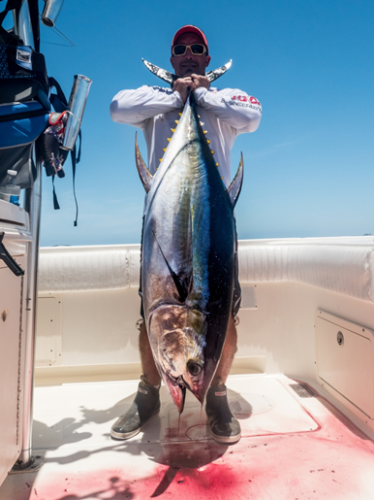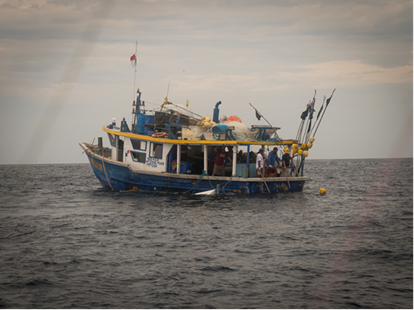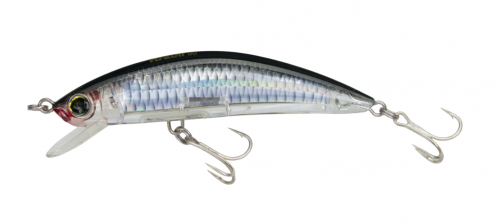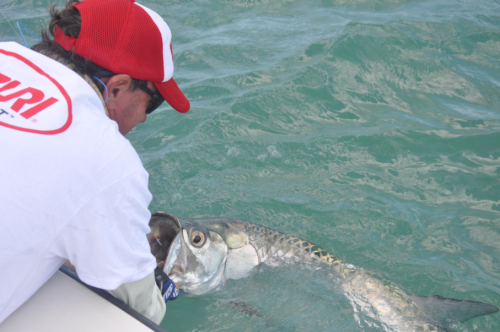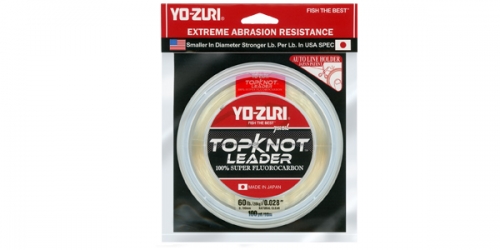INFORMATION
Fly Fishing in Alaska by Jonathan Lobaugh
This summer I went up to Alaska for some seasonal work and the fishing of course. I went up with all the essentials including Yo-Zuri top knot fluorocarbon leader line and used that as my tip-it. The methods I used to in corporate this great leader line is I would connect 4ft of my TopKnot leader to a poly leader. I used Both a fast sink and floating Polly leader, and my connection knot used was either a Uni-Uni or the classic loop knot. This allowed me to fish different species on the go I used 10lb, 12lb, and 15lb Clear TopKnot Leader it worked perfectly allowing me to land all my fish this summer. If you are a fly fisher man try this method and you definitely won’t regret the quality of Yo-Zuri TopKnot!
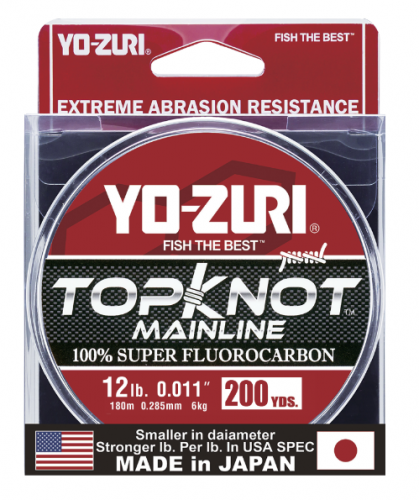
Also never forget the Yo-Zuri Pins Minnow for the days when casting a fly just does not work. Typically I like throwing the Pin’s minnow on light tackle with 6lb Yo-Zuri Hybrid. I’ve had great success throwing the 3 1/2″ model in Hot Pink Trout and Rainbow Trout.
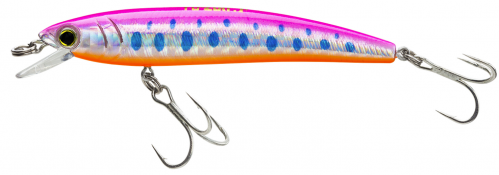
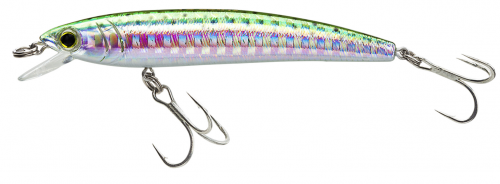
RATTL’N VIBE: WHEN, WHERE, HOW by Chase Brooks
The Yo-Zuri Rattl’n Vibe is a great bait that can be utilized all year-round, however it really shines when you are needing a reaction bite to catch finicky fish. It is also a great baitfish imitator and can work is several different applications.
WHEN:
As soon as the water temps begin to drop in late summer, and the fall transition begins, I tie on the Rattl’n Vibe. This is the time of year when the bass will really begin to concentrate on shad. Any shad imitating color, such as, Metallic Bleeding Shad, or Blue Chrome. (which ever color best represents the bait in your lake) will work best. I will continue to use the shad colors until late fall/ early winter. Once the water temps start to get around or below 60 degrees, the shad will begin to get less and less active. This is when I will switch to a red/ crawfish color. I will stick with the crawfish colors all the way through winter and into the early stages of the spawn. When the water really begins to warm up and the females begin to get on beds, I will switch to a bluegill/ perch color. The fish will be protecting their beds and fry from the perch and will be aggressive.

WHERE:
During the late summer/ early fall when I begin chasing shad, I will begin in the mouths of the major creeks that stem directly from the main lake. As the water temperature continues to drop the shad will continue to migrate further and further into the creeks, and you will need to follow them, by using your electronics. Most of the time these fish will suspend in the middle of the creeks instead of around the bank. Look for fish busting the surface, and don’t be scared to throw the Rattl’n Vibe over deep water. When you change to the red/ crawfish colors, I will begin to fish tighter to the cover. The crawfish will be buried under rocks and deep in vegetation. I will also concentrate on harder breaks that are close to deep water, channel swings, and points. As you make the transition to chasing spawning fish and change to your perch colors, you will have a few more options. The fish will spawn anywhere from the very back of the creeks to big main lake flats. I will move up shallow, and cover water until I find the females.
HOW:
Since the Rattl’n Vibe is best used as a reaction bait, speed is key. I use a very high-speed reel, anything that is 7.1:1 or faster. I use a rod that has a fast tip to keep from pulling the treble hooks from the fish’s mouth. If you are fishing heavy vegetation you will need a rod with a little heavier backbone, so you can rip the bait free of debris. Make long casts and a very speedy retrieve. Keep your rod tip pointed at the bait to keep it from rolling sideways. You will also need to adjust the height of your rod tip according to the desired depth you want the bait to run. If you are fishing heavy vegetation, you want the bait to skim just above the top of the vegetation bumping it on occasion. If your bait begins to bury up, a swift jerk of the rod( almost like a hook-set) will free the bait. If you are staying buried up, you may need to switch to a smaller size bait or raise your rod tip.
CHUNK- CRANK FAST- HANG ON
Sport Fish Panama Island Lodge – Fishing in Paradise by Chris Bishop
On occasion I get asked for recommendations for a “bucket list” or honeymoon destination. There are numerous amazing destinations around the world but my first answer is always Sport Fish Panama Island Lodge. If you’re looking for the total package: incredible fishing, exceptional service and breathtaking views, it checks all the boxes.
Located 12-miles off of the Pacific coast on the undeveloped jungle island of Isla Parida, inside Panama’s Chiriquí National Marine Park, in the heart of the Gulf of Chiriqui, the lodge is truly off the grid. Most importantly the location puts you in the middle of exceptional inshore fishing and significantly shortens the run to the world famous Hannibal Bank. The lodge is operated by owner Capt. Shane Jarvis who has been fishing the area for 20 years.
We visited the lodge last April for filming and product testing and were blown away by the experience. It was a relatively short flight from South Florida to Panama City, where we caught a quick connecting flight to David. The ride to the lodge through the river and out into the bay provided incredible scenery, the type that makes you instantly forget about the daily hostile and bustle you left behind. The boat dropped us off on a beach in a protected cove where we were met by staff who took us up the path through the jungle to the lodge. The lodge is perfect for fishermen, simple, laid back and comfortable. As you walk up you are greeted by a full bar and appetizers under the tiki hut followed by an amazing dinner. The food is all locally farmed or harvested from the ocean, some of the best Tuna, Dorado, Lobster and Conch you’ve ever had. Stepping out of your room in the morning you are greeted with majestic sunrises that words can’t do justice.
The first morning we jumped one of their two 33ft World Cats, yea no pangas with this operation. April is in the prime season for big Yellowfin Tuna and that was our main focus of the trip. It’s roughly a 40 minute run through calm seas to the start of the Tuna grounds. It’s not difficult to know when you find the schools with the insane abundance of frigate birds and spinner dolphin. Once you find the schools the goal is to get in front of the dolphin and get your baits out before the school changes direction. It can be tricky to judge which direction the dolphin are pushing the bait schools and to present your baits correctly but when you do double and triple hook ups of quality Yellowfin are common. On this day a lack of cloud cover made the tuna stay down and it took us a while to get our first bite. When we did it was worth wait, as a 115lb class Yellowfin hit the deck after a short fight. Not long after that a 100lb Yellowfin joined it.
Capt. Shane Jarvis is an expert in positioning the boat to help work the fish up as quick as possible and eliminate the need to move around the boat to follow the fish. Max heat is the name of the game and with the harness and top line equipment we were consistently putting triple digit fish in the boat in under 20 minutes. One of the things I love about this fishery is you don’t have to worry about sharks like you do in a lot of other areas of the world. After hitting the deck Shane’s highly skilled and friendly mate Johnny makes quick work of bleeding and cleaning the fish for that night’s dinner or for your return home. They can to vacuum seal your catch at the lodge and arrange for it to be packed with your luggage.
On the second day we were greeted with overcast skies which resulted in a wide open bite. The birds and dolphin were in tighter packs making it easier to get in the right position. The action on 60-150lb class Yellowfin was non-stop from the first bait until we were too beat to strap into another one. One of the unique experiences of the trip was pitching live baits to Yellowfins off the back of commercial boats. The commercial boats tie floating debris to the side of their boats and become slowly moving FADS. It provides them with a constant supply of live bait and combined with steady chumming they bring Tuna up behind their boat which they catch on hand lines.
When a school of Yellowfin started blowing up behind one next to us we pitched a live blue runners almost under their boat resulting in an instant hook up. The cooperation between the commercial boats and charters working the same school sometimes in tight quarters was something I had never experienced. I thought we might have an issue when one of my fish burned off a commercial line but after giving them a 100+ pound Yellowfin everything was smoothed over.
Sport Fish Panama Island Lodge uses the best equipment on the market for their offshore trips with top end rods and reels, Yo-Zuri SuperBraid, Yo-Zuri Fluorocarbon and Yo-Zuri hard baits, Mustad hooks and Grudens gear. The typical set-up for Yellowfin is a 30 class reel loaded with 65lb Yo-Zuri SuperBraid and a wind on leader of 80, 100 or 130lb Yo-Zuri Fluorocarbon to a Mustad circle hook. This set-up is used for live baiting blue runners or chunking sardines. For live baiting bonita’s for Blue and Black Marlin they upgrade to 50 class reels loaded with 80lb Yo-Zuri SuperBraid and 130, 150 or 200lb TopKnot Fluorocarbon to a Mustad circle hook.
For those that want to cast poppers, stick baits or swimming plugs to the Tuna or Dorado they have 18000 size spinning reels loaded with 65lb Yo-Zuri SuperBraid to 80lb Yo-Zuri TopKnot Fluorocarbon. Some of the top baits they use for casting are the Yo-Zuri Bull Popper, High Speed Vibe, Diving Slider and Mag Darter. The front of the World Cat is equipped with a platform and a waist high railing that makes it very comfortable to cast offshore or around the islands even with a chop on the water.
Sport Fish Panama Island Lodge also offers outstanding inshore fishing opportunities for Roosterfish, Blue Trevally and a variety of Snapper including Mullet and Cubera. Both days we spend a couple hours fishing inshore on our way back to the lodge. The typical set up for inshore is slow trolling blue runners along the drop offs near the small islands, while an angler or two cast plugs along the shoreline and rock formations from the bow. The jungle back drops in these areas offer mesmerizing scenery. The contour of the bottom is dramatic, in many cases you are casting up against land and bringing the plug back into 80ft of water or more. The key is having a plug that casts long distances and has sturdy terminal tackle that won’t bend out with the extreme heat needed to keep fish out of the rocks. On this trip we did very well on Blue Trevally, African Pompano, Roosterfish and epic size Hound fish on Yo-Zuri Mag Darters, Hydro Minnow Long Cast and Hydro Poppers.
When you combine the fishing, accommodations, views, food, service and overall experience Sport Fish Panama Island Lodge is a first class operation. If you are looking for more information on the trip of a lifetime visit https://fishpanamatoday.com/.
Nighttime Bridge Fishing—By Mike Holliday
If you spend much time fishing bridges at night, then the Yo-Zuri Mag Minnow should be your go-to lure, because it’s simple to use, represents a variety of baitfish and is super effective. Living in South Florida, the lights from the bridges draw a lot of snook and tarpon, which are my main targets. As a rule, both species like to hunt the shadow lines cast by the bridge on the up-current side of the structure, although tarpon will regularly work the down-current side as well.
The fish like to station on the dark side of the shadow line so mullet swimming with the current won’t see them. When the mullet traveling in the lighted areas hit the dark, shadowed sections they tend to be blinded for a few seconds and often slow down or stop. That’s when the fish strike.
The key for fishing shadow lines is to position your boat parallel to the shadow line you plan to fish, then cast parallel to the bridge but 10 to 20 feet up-current of the shadow line, allowing you to slowly swim the lure into the shadows. You can mix up the length of the cast or the distance from the shadow line to make the lure swim through the area in different locations.
The majority of the time I fish a Mag Minnow I just cast it out and reel in slowly back to the boat, giving it no action so it looks like a hapless baitfish just swimming along. Every few casts I’ll change it up and retrieve the lure with a stop and go action, ripping it along with a sweep of the rod and then letting the bait sit stationary for a second or two before moving it again. That will sometimes get reaction bites from fish that aren’t normally feeding.
Since the lighting on bridges is man-made and not natural, there’s a tendency for your leaders to reflect more light than during the daylight hours, so I always use Yo-Zuri fluorocarbon leader. I’ll also drop down in leader size from 50 pound test to 30 or 40 pound test to get more bites.
Covering water for more bites during the Fall!!! by Brandon Card
Fall fishing is one of the most diverse times to fish for bass. Bass in the fall can be found from deep water to super shallow water and everywhere in between. They don’t stay in one area long this time of year because they are always on the move in the fall. The reason why bass move so much this time of year is because they are chasing shad that are migrating from their deep water, main lake, summertime haunts to the shallows of creeks and rivers. This time of year I really try to target shallow water in creeks because I like fishing areas where I know more bass are coming.
Anytime I’m fishing shallow water creeks in the fall, I love covering water and catching active fish. Two of my favorite baits for this situation are Yo-Zuri 3DB Pencil and a Hardcore Crank 2+. I like bone color for the 3DB Pencil and gizzard shad color for the Crank 2+. The key this time of year is putting the trolling motor down and covering miles of bank. The only time I slow down is when I come to any piece of wood cover. If I’m seeing lots of surface activity like shad flickering on the surface or bass chasing bait, I will throw the 3DB Pencil. When I’m not seeing much surface activity, that tells me that the shad are closer to the bottom and then I lean on the Crank 2+ more.
I use the same rod and reel for both baits, and the only thing that is different is the line selection. An Abu Garcia Veritas rod (7′ medium) paired with an Abu Garcia Revo MGX reel (8.0:1) gets the nod for both techniques. I use 40lb Yo-Zuri Super Braid for the 3DB Pencil and 12lb Yo-Zuri TopKnot Fluorocarbon for the Hardcore Crank 2+.
Fall Hard Bait Fishing – 3DR & 3DS Mid Crankbaits, by Clent Davis
This is the time of the year for small crankbaits. The baitfish are small, and the bass all over the country are tuned in to these tiny baitfish as their primary food source. This time of year, I like to pick up small, baits like the Yo-Zuri 3DR and 3DS Midcrankbaits and cover some water. My favorite colors are Real Gizzard Shad and Tennessee Shad.
These baits are so effective, that I’ve nicknamed them my “Auto Bass” baits, because it always catches ‘em. The 3DR and 3DS Mid crankbaits run about six-feet-deep and even though they have a small profile, they make their presence known in the water with a fairly wide wobble that gets their attention.
I like to fish them in the fall by running to the backs of creeks and pockets and covering the bank. Shad typically move towards the backs of creeks in the fall, and making those moves myself makes the most sense. I use a 7’1” Medium-Light Phenix Feather rod and a 6.2:1 retrieve speed Shimano Curado200K reel spooled with 10-pound-test Yo-Zuri Top Knot Fluorocarbon.
I always start with a nice medium speed retrieve, speeding up and slowing down to get a feel for how aggressive the fish are. But, I am careful to not let myself get in too much of a rhythm with my retrieve. It’s really important to make the lure deflect off of rocks, stumps, docks or anything in the water that will cause the lure to change directions; that’s what really causes the fish to react.


